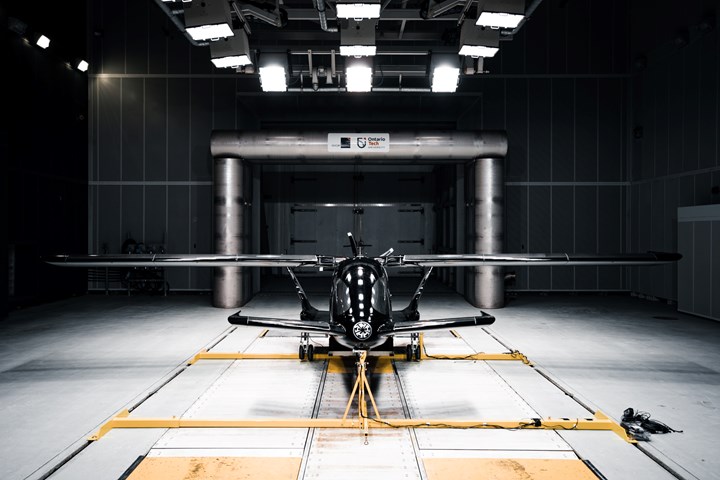Horizon Aircraft completes wind tunnel transition flight testing
The company anticipates that its Cavorite X5 hybrid eVTOL will be ready for full-scale flight tests in 2025.

Horizon Aircraft (Toronto, Ontario), developer of hybrid electric vertical take-off and landing (eVTOL) aerial vehicles, announces that it has completed initial transition flight testing of its Cavorite X5 50% scale eVTOL prototype in the world class ACE Climatic Wind Tunnel.
Brandon Robinson, CEO of Horizon Aircraft, says, “Aircraft performance exceeded our expectation. We explored forward speeds of up to almost 100 kilometers/hour, measuring aerodynamic forces, control authority, and mechanical system function with the wings open at varying fan speeds. We were particularly happy with pitch and roll stability and control throughout the entire transition envelope, as well as the embedded fan performance. Having real-world test results match our detailed predictions was further endorsement of our world class engineering. We can now use these results to refine our CFD modeling and further de-risk the outdoor transition flight test program that is beginning soon.”
Horizon says its innovative and patented hybrid eVTOL concept enables the aircraft to fly 98% of its mission in a very low-drag configuration like a traditional aircraft and is one of the only eVTOL aircraft currently able to do so. Flying most of the mission as a normal aircraft is safer, more efficient and will be easier to certify than radical new eVTOL designs, the company claims. The aircraft can also operate in short takeoff and landing (STOL) or conventional takeoff and landing (CTOL) modes. The full-scale aircraft will be powered by a hybrid electric architecture that can recharge the battery array in-flight while providing additional system redundancy and flexibility.
Horizon Aircraft will soon move to outdoor transition flight testing as the company continues the detailed design of its full-scale aircraft, anticipating final assembly for flight testing in 2025.
Related Content
-
Welding is not bonding
Discussion of the issues in our understanding of thermoplastic composite welded structures and certification of the latest materials and welding technologies for future airframes.
-
Plant tour: Collins Aerospace, Riverside, Calif., U.S. and Almere, Netherlands
Composite Tier 1’s long history, acquisition of stamped parts pioneer Dutch Thermoplastic Components, advances roadmap for growth in thermoplastic composite parts.
-
Industrializing additive manufacturing in the defense/aerospace sector
GA-ASI demonstrates a path forward for the use of additive technologies for composite tooling, flight-qualified parts.
.jpg;width=70;height=70;mode=crop)


